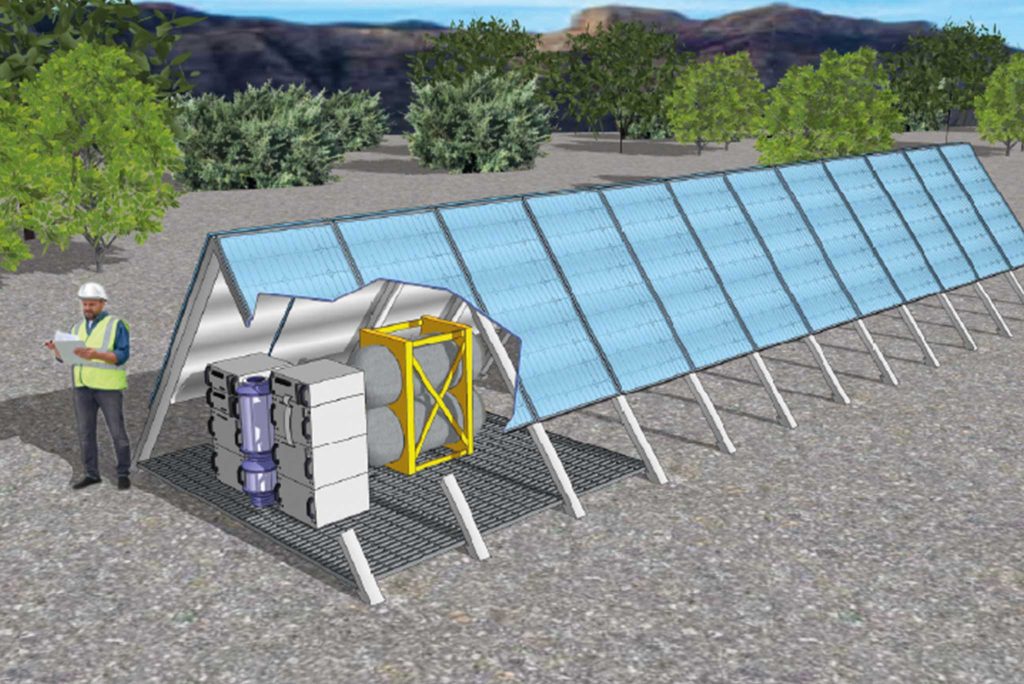Renewable carbon neutral methane to be produced in south-west Queensland
A new power-to-gas trial will pump renewable methane directly into Australia’s east coast gas grid.

ARENA has announced $1.1 million in funding for the gas operator APA Group to build a Renewable carbon neutral methane demonstration plant in south-central Queensland.
The renewable carbon neutral methane project will trial an innovative way of producing renewable hydrogen using an Anion Exchange Membrane (AEM) electrolyser powered by solar PV. The system draws water from the atmosphere to produce hydrogen, which in turn is converted to methane through a reaction with carbon dioxide, also extracted from the air.
The plant will produce 620kg of renewable hydrogen per year for conversion into 74 gigajoules of carbon neutral methane. While C02 is emitted at the point of use, emissions are balanced by carbon extracted from the atmosphere during production.
The APA Group will build the demonstration facility at their Wallumbilla Gas hub, situated about 475 kilometres west of Brisbane. Methane produced will be injected directly into the 7500 kilometres of gas pipelines that link Victoria, Queensland, New South Wales and South Australia.
Why convert hydrogen to methane?
Power to gas offers a way to store solar electricity in the form of gas in the gas network. Previous ARENA funding recipient Jemena is currently building a demonstration project in western Sydney using hydrogen as the end use gas, but there are limits to the concentration of hydrogen that can be used and it can only be carried in certain pipelines.
By producing renewable methane, APA is producing a fossil free natural gas which can be blended into the network at higher concentrations and could be stored in pipelines that are not compatible with hydrogen.

Project partner Southern Green Gas will supply their modular “virtual gas well” technology, which they say can provide a reliable supply of carbon neutral gas for at least 20 years.
APA Group’s CEO and Managing Director Rob Wheals believes the project will help to determine whether the technology offers a viable way to produce renewable methane at scale.
“We know the science of producing methane. This unique project is the first step in testing whether it is possible on an industrial scale to create methane, using solar-generated electricity, water and CO2 from the atmosphere,” Mr Wheals said.
“With this project we’re aiming to determine whether this carbon neutral process might be part of the green energy solution of the future, and if our pipelines can be used to transport pure renewable energy domestically or to be exported.”
He said APA is excited about the project, which he believes is a great example of government support for innovation in the Australian energy industry.
“ARENA’s support means we can work to understand the costs and benefits of generating renewable methane for use in the existing East Coast Gas Grid,” Mr Wheals said.
ARENA is supporting the project as part of its work to accelerate Australia’s hydrogen industry, which according to the National Hydrogen Strategy could create nearly 8000 jobs and $11 billion in GDP by 2050.
How is renewable methane created?
- Water is captured from air
- Electrolyser powered by solar energy splits water into H2 and O2
- Oxygen is released leaving hydrogen
- The methanation reactor combines the hydrogen with carbon dioxide extracted from the air
- Renewable methane is produced.

What will be the role of renewable methane?
ARENA CEO Darren Miller said that the gas network is expected to play an important role in the decarbonisation of Australia’s energy system.
“Renewable methane is in effect, indistinguishable from the methane that currently fills our natural gas pipelines. Through a new and innovative approach, the project will capture moisture in the air to produce renewable hydrogen as a precursor to renewable methane,” Mr Miller said.
“At scale, renewable methane has the potential to be a significant source of Australia’s future natural gas requirements all through the deployment of solar energy and capturing the water from the atmosphere. Renewable methane is compatible with Australia’s developing hydrogen sector in that known technologies can convert methane to hydrogen and vice versa,” he said.
Attention shifting to green gases
While the electricity sector has led the transition to renewables, natural gas makes up a larger share of Australia’s total energy use. Finding ways to decarbonise the industry will be important for Australia to achieve its commitments in the Paris climate agreement.
ARENA is providing funding to projects that could support these efforts, ranging from direct injection of hydrogen into gas grids, to use of renewable hydrogen for ammonia production and production of biogas from waste products.
LEARN MORE ABOUT RENEWABLE HYDROGEN
Projects like Jemena’s power to gas trial in Sydney’s west, ATCO’s Clean Energy Innovation Hub and the Australian Hydrogen Centre are helping to inform the gas industry’s efforts to reach “near” net zero emissions by 2050.
Beyond the hydrogen projects, there is an opportunity to boost Australia’s use of biogas – the naturally occurring biofuel emitted as organic material breaks down. There is no shortage of feedstock – rubbish tips, water treatment plants and agricultural processors are overrun with fertile waste products.
Germany provides a blueprint of what is possible. Their network of 9500 biogas plants operating nationally has an installed capacity of around 5 GW, 3.5 times the capacity of the Phillipsburg 2 nuclear power plant that is scheduled to close at the end of the year.
Read more about ARENA’s hydrogen and biogas projects.
LIKE THIS STORY? SIGN UP TO OUR NEWSLETTER

ARENA